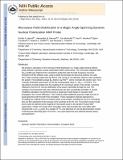Microwave field distribution in a magic angle spinning dynamic nuclear polarization NMR probe
Author(s)
Nanni, Emilio Alessandro; Barnes, Alexander B.; Matsuki, Yoh; Woskov, Paul P.; Temkin, Richard J.; Corzilius, Bjorn; Griffin, Robert Guy; ... Show more Show less
DownloadGriffin_Microwave Field.pdf (2.323Mb)
PUBLISHER_CC
Publisher with Creative Commons License
Creative Commons Attribution
Terms of use
Metadata
Show full item recordAbstract
We present a calculation of the microwave field distribution in a magic angle spinning (MAS) probe utilized in dynamic nuclear polarization (DNP) experiments. The microwave magnetic field (B[subscript 1S]) profile was obtained from simulations performed with the High Frequency Structure Simulator (HFSS) software suite, using a model that includes the launching antenna, the outer Kel-F stator housing coated with Ag, the RF coil, and the 4 mm diameter sapphire rotor containing the sample. The predicted average B[subscript 1S] field is 13 μT/W[superscript 1/2], where S denotes the electron spin. For a routinely achievable input power of 5 W the corresponding value is γ[subscript S]B[subscript 1S] = 0.84 MHz. The calculations provide insights into the coupling of the microwave power to the sample, including reflections from the RF coil and diffraction of the power transmitted through the coil. The variation of enhancement with rotor wall thickness was also successfully simulated. A second, simplified calculation was performed using a single pass model based on Gaussian beam propagation and Fresnel diffraction. This model provided additional physical insight and was in good agreement with the full HFSS simulation. These calculations indicate approaches to increasing the coupling of the microwave power to the sample, including the use of a converging lens and fine adjustment of the spacing of the windings of the RF coil. The present results should prove useful in optimizing the coupling of microwave power to the sample in future DNP experiments. Finally, the results of the simulation were used to predict the cross effect DNP enhancement (ϵ) vs. ω[subscript 1S]/(2π) for a sample of [superscript 13]C-urea dissolved in a 60:40 glycerol/water mixture containing the polarizing agent TOTAPOL; very good agreement was obtained between theory and experiment.
Date issued
2011-03Department
Massachusetts Institute of Technology. Department of Chemistry; Massachusetts Institute of Technology. Department of Physics; Massachusetts Institute of Technology. Plasma Science and Fusion Center; Francis Bitter Magnet Laboratory (Massachusetts Institute of Technology)Journal
Journal of Magnetic Resonance
Publisher
Elsevier
Citation
Nanni, Emilio A., Alexander B. Barnes, Yoh Matsuki, Paul P. Woskov, Björn Corzilius, Robert G. Griffin, and Richard J. Temkin. “Microwave Field Distribution in a Magic Angle Spinning Dynamic Nuclear Polarization NMR Probe.” Journal of Magnetic Resonance 210, no. 1 (May 2011): 16–23.
Version: Author's final manuscript
ISSN
10907807
1096-0856